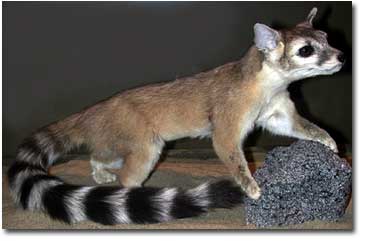Ringtail Cat
The name "ringtail" comes from the seven or
eight black rings on the animalís tail. Although they are not related to cats,
people have referred to them as minerís cat (historically appreciated as a
mouser), civet cat (because of pungent secretion from anal glands), and
cacomistle (an Aztec Nahuatl term meaning half mountain lion). Along with
raccoons and coatimundis, ringtails are members of the Procyonidae (raccoon)
family. The scientific name, Bassariscus astusus, comes from bassar (fox), isc
(little), and astut (cunning).

Description
If one were to design a climbing animal to exploit the desertís cracks, ledges and vertical cliffs, the ringtail might be it. Their considerable tail provides balance for negotiating narrow ledges and limbs, even allowing them to reverse directions by performing a cartwheel. They can rotate their hind feet 180 degrees, giving them purchase for rapidly descending cliffs or trees as well as cacti. Furthermore, ringtails can ascend narrow passages by stemming (pressing all feet on one wall and their back against the other or pressing both right feet on one wall and both left feet on the other), and wider cracks or openings by ricocheting between the walls.
The body is compact and sleek with an elongated, pointed muzzle. Dark brown to black hairs surround the large eyes, creating a prominent mask. Large grayish-brown ears are edged in white. A ringtailís total length ranges between 24 and 32 inches with a tail length of 12 to 17 inches. They weigh from 30 to 39 ounces.
If one were to design a climbing animal to exploit the desertís cracks, ledges and vertical cliffs, the ringtail might be it. Their considerable tail provides balance for negotiating narrow ledges and limbs, even allowing them to reverse directions by performing a cartwheel. They can rotate their hind feet 180 degrees, giving them purchase for rapidly descending cliffs or trees as well as cacti. Furthermore, ringtails can ascend narrow passages by stemming (pressing all feet on one wall and their back against the other or pressing both right feet on one wall and both left feet on the other), and wider cracks or openings by ricocheting between the walls.
The body is compact and sleek with an elongated, pointed muzzle. Dark brown to black hairs surround the large eyes, creating a prominent mask. Large grayish-brown ears are edged in white. A ringtailís total length ranges between 24 and 32 inches with a tail length of 12 to 17 inches. They weigh from 30 to 39 ounces.